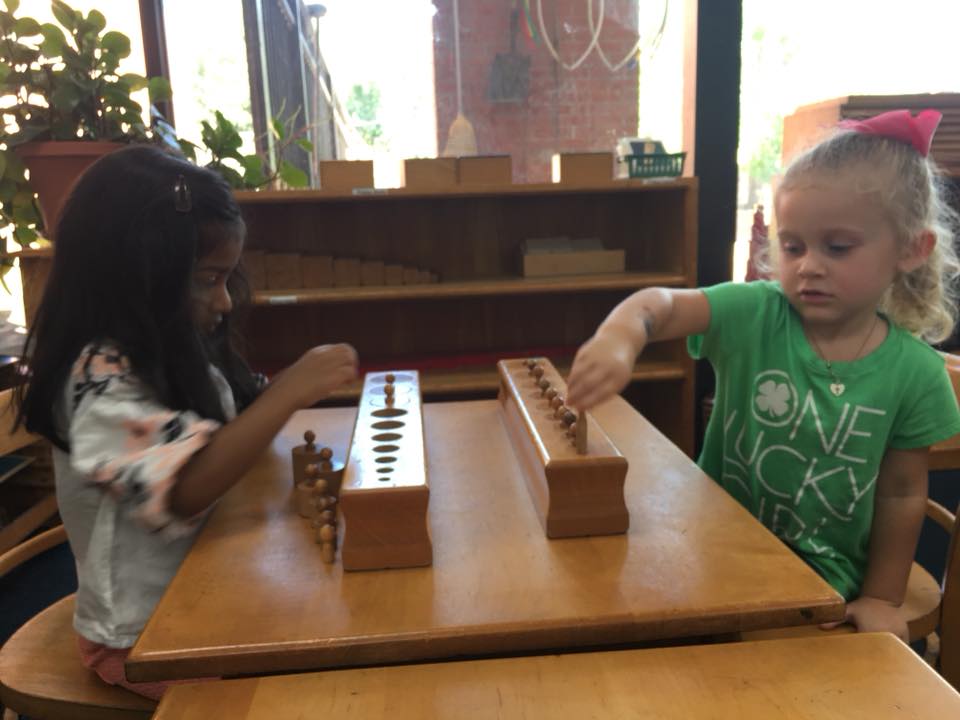Language
How to Make Sounds
a as in apple
b as in bird
c as in cat
d as in doll
e as in elf
f as in feather
g as in goose
h as in hat
i as in igloo
j as in jug
k as in kite
l as in lock
m as in mittens n as in net
o as in ostrich
p as in pumpkin
q as in quarter
r as in ring
s as in seven
t as in teepee
u as in umpire
v as in violin
w as in watermelon
x as in box
y as in yellow
z as in zebra
Movable Alphabet
In the Montessori environment, writing nearly always precedes reading. But this writing is not constrained by the child’s motor control over a pencil. It is instead done with a set of wooden letters by which the child can say the sounds and lay out the correct wooden letters. With small objects to guide his efforts, the child can first say the name of the object very slowly so he can hear each sound ”p–i–g”. He then selects the letter for the first sound and lays it on the mat beside the object. Then he picks the letter for the second sound and lays it to the right of the first letter. This construction of words may continue for a long time. It may even progress to sentences or stories. In addition to the objects, there are many sets of labels in the classroom to serve as guides in constructing words. At a time when the child becomes proficient with forming letters with a pencil, the teacher may show the child how to write with a pencil the same words he has constructed with wooden letters. The important point is that the child’s intelligence is not constrained by his muscular ability to control a pencil.
At home, encourage your child’s interest in the sounds of words, particularly ending and middle sounds. Continue to read aloud with your child, delighting with him in poetry, adventure, and expanding knowledge.
Sand Paper Letters
The sandpaper letters consist of three sets of large wooden cards with letters cut out of sandpaper mounted on them. One set consists of red cards with the consonants on them. One set consists of blue cards with the vowels mounted on them. The third set consists of green cards with two letters mounted on them that have one sound, such as ‘sh’, ‘ch’, and ‘tion’. These are the child’s first introduction to the sounds of letters. They are introduced consonants first. The sounds are given only phonetically, which is how the child hears the sound; for example, the child hears ‘t’ at the beginning of ‘top’, not ‘tee’. In the first introduction of vowels, the short vowel sound (apple, egg, insect, ostrich, and umbrella) is used. Using two or three cards at a time, the teacher shows the child how to trace the letter with the first two fingers of his dominant hand while he quietly says the sound of that letter.
Use of this material gives the child a three-fold impression — he sees the shape, feels the shape, and hears the sound. The fact that the letter is made of sandpaper rather than ink invites the child to trace the shape. This is an important step in learning to write. Repetition of this exercise fixes the path of each letter in the child’s muscle memory. As soon as the child learns a few consonants and vowels, he may begin constructing three-letter words using the movable alphabet.
At home, your child will have an intense interest in the sounds of words. Watch carefully how you enunciate so that both the beginning and ending sounds are clearly audible in your speech. Play games with words that start or end with a particular sound. Don’t press your child into writing or reading. Let him lead you in what his interests are. It is not necessary to ‘practice’ a lot at home. Your child will gradually bloom into both reading and writing. Your own obvious enjoyment of reading and writing and of reading good literature out loud to your child are all the encouragement your child needs to want to acquire this most wonderful skill.
Metal Insets
The metal insets are an exercise to strengthen and reinforce the child’s muscles so he may use a pencil in writing. With metal insets, the child creates beautiful designs and he does not weary of practice because it is so enjoyable. The metal insets are a tray of ten individual metal squares with different blue shapes cut out of them. The child is first shown how to trace around the edge of the inside piece and he is taught the name of the shape. He is then taught to trace around the shape of the outside piece with a pencil, in stencil fashion. Colored pencils are used on colored paper. After the figure is traced, the outline is filled in with any number of different lines (vertical, horizontal, or wavy).
At first the child’s strokes are erratic and extend beyond the outline. By degrees they become more accurate and uniform. Progress in control of the pencil can be detected by comparing designs made over a period of months. Eventually, more intricate designs may be created by superimposing other shapes over the original. When colored well, this work resembles stained glass. The child may return to this equipment long after he has mastered writing because of the creative outlet it provides.
At home, allow your child access to activities that develop fine motor control. Needlework, using crayons in intricate designs, and building models are excellent fine motor development exercises as well as reinforcing for the enjoyment they provide. Encourage your child’s creativity with combining colors in various art activities and his craftsmanship in executing the various projects.
We teachers can only help the work going on, as servants wait upon a master.
